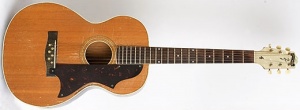Model 4 Flat Top
|
The Model 4 was the top of the line, the largest and most ornate of the Models 1 though 3. The "Numbered Series" Epiphone guitars appear to be a transitional model between the "Recording Series" (Models 'A' through 'E') of the late 20's, and Epi's first Masterbilt f-hole archtops of the early 30's. Larger and louder than the Recording Models, the Numbered Series represented a radical breakthrough in the effort to design acoustic guitars with sufficient projection to replace the banjos of the early big band era. Significantly, the guitars were the first Epis with a 14 fret neck, and the first to adopt the 25.5" scale, over seven years before Gibson made the long neck standard on their largest archtops. Another innovative features is the self-centering bridge, a rosewood retainer for the bone saddle that slides in a channel on the front of the bridge. The bridge pins are staggered in placement, and a suspended bound tortoise pickguard was held in place without a bracket, employing an ingenious retaining pin to the bridge, in a fashion similar to Gibson mandolins of the teens |
- 1928-1932
- Made at the Long Island City, NY plant
Body:
- Solid spruce top
- Arched, laminated maple back
- Maple sides
Neck:
- Set maple neck
- Maple headstock with pearloid veneer
- Epiphone banner logo on headstock
- Rosewood fingerboard with dot inlays
- Double dots at 7th & 12th frets
- Bone nut
- 25.5" scale
Binding:
- 1-ply pyralin body, neck & heel
- 14-ply pyralin rosette
Hardware:
- Celluloid pickguard
- 3-per side platter tuners with brass worm gear
- Ivory tuner buttons
- Ebony bridge with bone saddle
- Staggered maple bridge pins
Electrics | Archtops | Acoustics | Basses | Bluegrass | Amplifiers | Promotional Guitars

